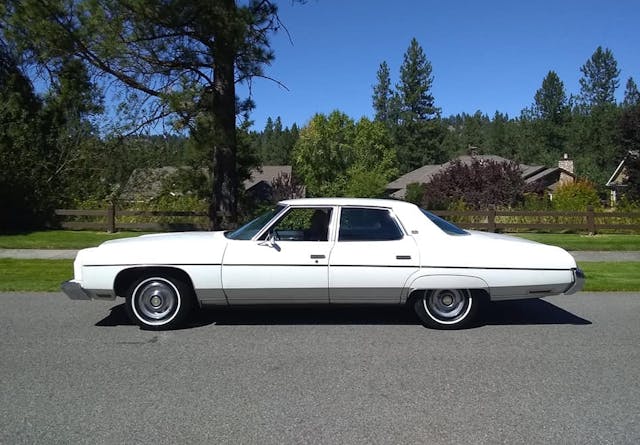The 1973 Caprice was luxury for a low price

For most of the postwar years and though the mid- to late ’70s, Chevrolet, Ford, and Plymouth constituted what could be called the “Low-Priced Three.” For many of those years, while they weren’t in the Cadillac, Lincoln, or Imperial class price-wise, prestige-wise and otherwise, they could typically be ladled up with options.

Many an Impala, Galaxie, or Fury III came out of the dealer lot with vinyl roofs, power windows, power locks, whitewall tires and 8-track tape players. But the Big Three didn’t really start loading them up until the mid ’60s, when they introduced true luxury models for the everyman.

Chevy and Ford both brought out their upper-crust offerings in 1965, Ford with the Galaxie 500 LTD and Chevrolet with the Caprice Custom option package for the Impala Sport Sedan. Both would become standalone models in 1966, which was the same year Plymouth brought out their luxo-Fury, the VIP.

While the VIP never sold in great numbers, and only lasted through model year 1969, the LTD and Caprice had some serious staying power. The LTD nameplate itself lasted through 1991, and the subsequent 1992–2011 Crown Victorias could be considered an extension of the LTD as well, though the acronym no longer appeared on fenders, C-pillars, or trunk lids.

The Caprice was available only as a four-door hardtop in 1965, but starting in 1966 a two-door hardtop and 6- and 9-passenger station wagons were offered as well. 1967 Caprices added even more chrome trim along their flanks, and fender skirts appeared on all non-wagon models. An elegant touch, and one that made the ’67s look very similar to 1967 Cadillacs at a distance.

From 1965 through 1970, Caprices had the same grilles and front-end styling as the lesser Impalas and Bel Airs, but starting in 1971, Caprice got a unique grille and fleur de lis emblem, instead of the Chevrolet bowtie. The ’71s were all new, and bigger than ever before. They also looked even more like a Cadillac. Interiors were suitably plush as well. But that’s enough Caprice history, let’s get to today’s featured ’70s land cruiser.


This 1973 Caprice pillared sedan was recently acquired by my friend Jason Bagge, who regularly finds old cars, fixes them up, enjoys them for a month or three, then sells it and finds another old car to rejuvenate. This car was saved from the junkyard, as these photos show. It could have been a goner, but before it actually went into the yard, it was rescued. It sat for many years. As Jason related, in 2001 it had 79,812 miles. Today, it has 81,566.

It passed through a couple of owners first, and Jason got it this past summer. It is one of 58,126 four door sedans built; base price was $4064. The sportier pillarless sedan was $4134 and the coupe was $4082. New for ’73 was the $4345 Caprice convertible; 7339 were made.

Caprices came standard with a 150-hp 400-cubic-inch V-8 with a two barrel carburetor, though lesser Chevys could have the Turbo Thrift 250 six or Turbo-Fire 350-2 BBL V8 under their pool-table-sized hoods.

And naturally, those wanting more oomph for their Caprice could order a 175-hp Turbo-Fire 350 with four barrel carb, or the top-of-the-line 4-bbl 454 V-8, with 245 horses. Jason’s car has the standard 400 bent eight. It also has factory Four Season air conditioning.

It is painted Antique White with a blue interior in nylon knit cloth and vinyl. This trim was available in red, black or green as well. All Caprices came standard with power front disc, rear drum brakes, Turbo Hydra-matic automatic transmission, and variable ratio power steering. All coupes and sedans rode a 121.5-inch wheelbase. Overall length was 221.9 inches.

As the 1973 brochure extolled, “Perhaps you’ve noticed, there’s a new side of Chevrolet that’s been emerging quietly over the past few years.”

“We’re talking about luxury. About elegance. Qualities that led us ultimately to the stately Caprice … this year, we’ve carried these qualities to ever greater heights in our aristocratic series of Caprices.”

“We made it long, wide and stately with an imposing grille and subtle touches that set it apart not only from other Chevrolets but from other cars in its price range. Uppermost in its ride. Incredibly smooth and steady, the most comfortable ride we’ve ever constructed.”

Of course, with prices in the $4000–$4500 range (Cadillacs ran from $5800 through $12,000, depending on whether you wanted a Calais coupe or Series Seventy-Five limo), there were some compromises. Such as many luxury car features being optional, such as A/C, power windows, power door locks, cruise control, tilt wheel and a vinyl roof. He’s really been enjoying working on it this summer (it’s not totally done, but is looking very good), in between cruising in the car with his dad-who can be seen riding shotgun in several pictures.

Jason has had some really nice 1970s Detroit cruisers—a ’72 Bonneville, ’76 Caprice Landau, ’71 Eldorado coupe and many, many others—but this one I really like, and I have told him over and over to keep this one. But then, I’m biased, as I love the 1973 Chevrolets, particularly Caprices. It’s probably because the 1973 James Bond film, Live and Let Die, is my favorite Bond movie, and featured lots of 1973 Chevys, from C10 pickups to Bel Air police cars to Novas and Chevelles. Hopefully he takes heed and retains this survivor, as these ’71–’76 big Chevrolets are getting harder and harder to find these days!


